Abstract
Asia is the world's most dynamic area. Asthma is a major chronic disease in Asia, like other continents. However, unlike childhood asthma, the epidemiological burden of asthma in Asian adults has been unclear. Here we reviewed the currently available literatures on the epidemiology of adult asthma in the Asian community populations. Adult asthma prevalence was generally lower in Asian than in Europe, but the increasing trends suggested the disease burden to rise in the near future. However, for better understanding, it may be essential to prepare for the Asian multinational network for the standardization and collaboration of research.
Asia is the world's largest and most populated continent. It covers 30% of the Earth's land area, and hosts 60% of the world's current population [1]. During recent decades, the Asian population has quadrupled, and the economy has enormously grown up [2]. Thus now, Asia is the world's most 'dynamic' region.
Asthma is a major chronic disease in Asia, like other continents [3, 4]. The prevalence of childhood asthma has continuously increased over the decades in Asia [5]. This increasing significance has been well reflected in the activity of asthma research in Asian countries, which has doubled during the last decade [6]. However, in Asian adults, the epidemiological burden of asthma is largely unknown this lack is quite in contrast to extensive and systemic research efforts ongoing for childhood asthma epidemiology such as the International Study of Asthma and Allergies in Childhood (ISAAC) projects in Asian children [5].
How prevalent is asthma in Asian adult community populations? Is asthma increasing in Asian adults too? If we extrapolate previous findings from Asian children or the European Community Respiratory Health Survey (ECRHS) [7], we might simply expect that asthma is also increasing among Asian adult populations. However, factors underlying the epidemiology are not uniform across different demographic groups; and thus, there should be many questions to be directly answered in this population.
Here we aimed to review the literature on the epidemiology, and to identify tasks to improve our understanding of asthma in Asian adult populations.
We conducted a semisystematic literature review to identify papers reporting the prevalence of asthma among Asian adult community populations. The PubMed was searched with the term 'asthma AND (epidemiology OR prevalence OR incidence)' for Asian countries. The publication period was not restricted, but the language was confined to English publication. Finally, we identified 42 original studies reporting the asthma prevalence in Asian adults. Outcomes were extracted for study design, population, research questions, case definition, and asthma prevalence (Tables 1, 2, 3).
Prevalence data from nationwide surveys were summarized in Table 1. A total of 14 prevalence data have been reported from 9 countries. The prevalence varied from 0.7% to 11.9%, but the asthma definitions varied widely. Only one study had utilized objective testing (bronchodilator response) to define asthma, whereas others used questionnaires. Seven studies asked the 1-year prevalence of 'current asthma (defined by recent symptoms plus physician diagnosed asthma)' [8, 9, 10, 11, 12, 13, 14], but their definitions also varied between studies. These nationwide findings were depicted in Fig. 1.
Local area surveys were summarized in Table 2 (28 studies from 13 countries). Specifically, local area prevalence in China was reported as 0.7-3.8% [15, 16, 17, 18, 19]. In two Korean local area studies, current asthma prevalence was 3.6-5.8% when defined by combination of questionnaire and methacholine challenge tests [20, 21]. In Ulaanbaatar, Mongolia, ever physician diagnosis of asthma varied from 1.1% in 1999 to 4.7% in 2009 [22, 23]. In Iran, three different local area surveys found current asthma prevalence as 1.4-6.1% [24, 25, 26]. In Al Ain, the United Arab Emirates, asthma prevalence was the highest as 12%, but the definition was not strict [27]. Four local area studies were conducted in India; the prevalence of current asthma ranged from 2.4% to 3.5% [28, 29, 30, 31]. Other South & Southeast Asian studies found 2.4-3.9% prevalence [32, 33, 34, 35, 36].
Interestingly, asthma was frequently reported to increase with aging in Asia. In two different local population surveys in Korea, current asthma (defined by current wheeze and positive airway hyperresponsiveness) was consistently more prevalent among the elderly (12.7-15.3%) [20, 21]. These age-related increase were similarly observed in several questionnaire-based studies from China [15, 17], Taiwan [37], Mongolia [22], Korea [38], Iran [25], India [8, 11, 28, 31], and Bangladesh [32, 39]. In Japanese nationwide surveys using questionnaires, only wheeze but not physician diagnosed asthma increased with aging [10]. The age-specific prevalence of asthma in elderly groups (≥60-70 years old) was presented in Fig. 2.
Despite the heterogeneity in study designs and years, we presented a crude prevalence map in order to have a quick glimpse of geographical variation of asthma prevalence in Asian countries (Fig. 3). Each representative prevalence was primarily retrieved from nationwide data, if available; otherwise, the pooled estimation from available local area studies was utilized as alternatives. To summarize, currently available data indicated that crude asthma prevalence was generally less than 5% in Asian adults. The Asian prevalence estimate was lower than the European data from the ECRHS phase I surveys (median, 4.5%; range, 2.0-11.9% in stage 1; and median, 5.2%; range, 1.2-13.0% in stage 2 [7]). These geographical difference between Asian and European populations were in line with the ISAAC surveys for childhood asthma [40].
In a recent systematic review, 48 well-designed cohort or repeated cross-sectional studies were analyzed to determine if asthma prevalence was declining recently (1990-2008) [41]. The analyses concluded that asthma prevalence recently continues to increase or remains stable in most parts of the world. However, the included studies were mostly childhood population studies, or from western populations, possibly due to lack of high quality longitudinal studies in Asian adult populations. In European adults, the ECRHS phase I and II comparison analyses (1991-1993 vs. 1998-2003) found the significant increase in 'asthma attack' (+0.8%; 95% confidence interval [CI], 0.2 to 1.4; p = 0.001), 'current asthma medication (+2.1%; 95% CI, 1.6 to 2.6; p < 0.001) or 'diagnosed asthma' (+2.2%; 95% CI, 1.6 to 2.9; p = 0.037), but no significant change in 'current wheeze' (-0.9%; 95% CI, -1.9 to 0.2; p = 0.122) over the 5- to 10-year follow-ups of young adults [42].
In our review, temporal changes in Asian adult asthma prevalence were identified in three countries (Japan [43], Korea [38, 44], and Hong Kong [45]). Interestingly, the data demonstrated consistent trends for increasing prevalence, in several asthma definitions including ever asthma, current asthma, or current wheeze (Fig. 4). Statistical significance was directly calculated in the 12-year comparison studies from Hong Kong [45]; they found significant increase in current wheeze (7.5% in 1991 vs. 12.1% in 2003; p < 0.01) but borderline significance in ever asthma (5.1% in 1991 vs. 5.8% in 2003; p = 0.065). In a suburban area in Japan, current wheeze (4.2% in 1985 vs. 7.6% in 1999), ever asthma (5.1% in 1999 vs. 6.7% in 2006) and current asthma (1.5% in 1999 vs. 3.4% in 2006) all showed consistent increase over time [43].
It is not certain whether the adult asthma is also increasing in other Asian countries, as no other longitudinal data are currently available; however, considering the rapid urbanization in Asia, the prevalence is expected to increase in various developing countries. Within the same inherent genetic background, living areas have been associated with the risk of childhood asthma [46]. Adult asthma may be carried over from childhood disease, or newly develop by occupational or environmental irritant exposure [47].
We summarized the research questions addressed in individual studies based on their study purposes (Table 3). Prevalence estimation and risk factor exploration were the most frequent topic. Otherwise, various specific factors were examined in relation to asthma risk, including lifestyle factors (obesity [48, 49] and smoking [31, 33]), dietary or nutritional factors (vitamin D level [50], kimchi [44] or monosodium glutamate intake [16]), pollutant exposure [51, 52], psychiatric disorder [12], clonorchis infection [53], rhinitis [54], or staphylococcal enterotoxin sensitization [21]. These topics of interests have reflected the ideas of Asian researchers, regarding what may underlie the adult asthma.
Here we summarized the current status of epidemiological research on adult asthma in Asia. Overall prevalence was lower than 5% in Asian adult community populations, which appeared less prevalent than in European adult populations. Importantly, the prevalence of elderly asthma was 1.3-15.3% in Asia, which is relatively high. Because of the population aging due to rising life expectancy and/or declining birth rates in Asia, we have to pay attention to the elderly asthma in this region. However, the methodological heterogeneity was a major limitation hindering the comparison of regional prevalence, despite that the number of conducted studies was not so small in Asia. Temporal trends in prevalence suggested the recent increase of adult asthma in Hong Kong, Japan, and Korea; however, the findings warrant replication in other Asian developing countries.
For these, the utilization of standardized questionnaire tools needs to be encouraged in Asian countries. Although there is no gold standard definition for asthma in epidemiological surveys, at least the academic consensus should be made on the common framework and protocols. The ECRHS and the Global Allergy and Asthma European Network (GA2LEN) projects may be excellent examples to follow. The ECRHS project was initiated for adult respiratory diseases in 1990, consisting of 140,000 participants from 22 countries [7]; currently, the ECRHS phase III follow-up survey is undergoing. The GA2LEN project, consisting of 60 allergy centers from 20 European countries, was a more recent collaboration to integrate European research efforts and capacities for allergy and asthma, and to establish permanent international research network [55]. In each of the projects, the study protocols have been shared in every participating center. In this regard, it may be necessary to prepare for establishing the Asian network for allergy and asthma epidemiological research collaboration. The first workgroup meeting may be held in the next meeting of the Asia Pacific Association of Allergy, Asthma and Clinical Immunology.
References
1. Wikipedia. Asia [Internet]. San Francisco: Wikimedia Foundation Inc.;c2014. cited 2014 Apr. 10. Available from: http://en.wikipedia.org/wiki/Asia.
2. Bloom DE, Canning D, Rosenberg L. Demographic change and economic growth in South Asia: The WDA - HSG discussion paper series on demographic issues. St. Gallen: World Demographic & Ageing Forum;2011.
3. Thompson PJ, Salvi S, Lin J, Cho YJ, Eng P, Abdul Manap R, Boonsawat W, Hsu JY, Faruqi RA, Moreno-Cantu JJ, Fish JE, Ho JC. Insights, attitudes and perceptions about asthma and its treatment: findings from a multinational survey of patients from 8 Asia-Pacific countries and Hong Kong. Respirology. 2013; 18:957–967. PMID: 23730953.

5. Wong GW, Leung TF, Ko FW. Changing prevalence of allergic diseases in the Asia-pacific region. Allergy Asthma Immunol Res. 2013; 5:251–257. PMID: 24003381.

6. Klaewsongkram J, Reantragoon R. Asthma research performance in Asia-Pacific: a bibliometric analysis by searching PubMed database. J Asthma. 2009; 46:1013–1020. PMID: 19995139.

7. Janson C, Anto J, Burney P, Chinn S, de Marco R, Heinrich J, Jarvis D, Kuenzli N, Leynaert B, Luczynska C, Neukirch F, Svanes C, Sunyer J, Wjst M. European Community Respiratory Health Survey II. The European Community Respiratory Health Survey: what are the main results so far? European Community Respiratory Health Survey II. Eur Respir J. 2001; 18:598–611. PMID: 11589359.
8. Agrawal S, Pearce N, Ebrahim S. Prevalence and risk factors for self-reported asthma in an adult Indian population: a cross-sectional survey. Int J Tuberc Lung Dis. 2013; 17:275–282. PMID: 23317966.

9. Dejsomritrutai W, Nana A, Chierakul N, Tscheikuna J, Sompradeekul S, Ruttanaumpawan P, Charoenratanakul S. Prevalence of bronchial hyperresponsiveness and asthma in the adult population in Thailand. Chest. 2006; 129:602–609. PMID: 16537857.

10. Fukutomi Y, Nakamura H, Kobayashi F, Taniguchi M, Konno S, Nishimura M, Kawagishi Y, Watanabe J, Komase Y, Akamatsu Y, Okada C, Tanimoto Y, Takahashi K, Kimura T, Eboshida A, Hirota R, Ikei J, Odajima H, Nakagawa T, Akasawa A, Akiyama K. Nationwide cross-sectional population-based study on the prevalences of asthma and asthma symptoms among Japanese adults. Int Arch Allergy Immunol. 2010; 153:280–287. PMID: 20484927.

11. Jindal SK, Aggarwal AN, Gupta D, Agarwal R, Kumar R, Kaur T, Chaudhry K, Shah B. Indian study on epidemiology of asthma, respiratory symptoms and chronic bronchitis in adults (INSEARCH). Int J Tuberc Lung Dis. 2012; 16:1270–1277. PMID: 22871327.

12. Lu Y, Feng L, Lim L, Ng TP. Asthma, life events and psychiatric disorders: a population-based study. Soc Psychiatry Psychiatr Epidemiol. 2013; 48:1273–1282. PMID: 23370618.

13. Mahboub BH, Al-Hammadi S, Rafique M, Sulaiman N, Pawankar R, Al Redha AI, Mehta AC. Population prevalence of asthma and its determinants based on European Community Respiratory Health Survey in the United Arab Emirates. BMC Pulm Med. 2012; 12:4. PMID: 22340199.

14. Ng TP, Hui KP, Tan WC. Prevalence of asthma and risk factors among Chinese, Malay, and Indian adults in Singapore. Thorax. 1994; 49:347–351. PMID: 8202905.

15. Chan-Yeung M, Zhan LX, Tu DH, Li B, He GX, Kauppinen R, Nieminen M, Enarson DA. The prevalence of asthma and asthma-like symptoms among adults in rural Beijing, China. Eur Respir J. 2002; 19:853–858. PMID: 12030724.

16. Shi Z, Yuan B, Wittert GA, Pan X, Dai Y, Adams R, Taylor AW. Monosodium glutamate intake, dietary patterns and asthma in Chinese adults. PLoS One. 2012; 7:e51567. PMID: 23240044.

17. Wang D, Xiao W, Ma D, Zhang Y, Wang Q, Wang C, Ji X, He B, Wu X, Chen H, Zhang Y, Jiang Y, Yin J. Cross-sectional epidemiological survey of asthma in Jinan, China. Respirology. 2013; 18:313–322. PMID: 23121025.

18. Wilson D, Takahashi K, Pan G, Chan CC, Zhang S, Feng Y, Hoshuyama T, Chuang KJ, Lin RT, Hwang JS. Respiratory symptoms among residents of a heavy-industry province in China: prevalence and risk factors. Respir Med. 2008; 102:1536–1544. PMID: 18684604.

19. Wu F, Guo Y, Kowal P, Jiang Y, Yu M, Li X, Zheng Y, Xu J. Prevalence of major chronic conditions among older Chinese adults: the Study on Global AGEing and adult health (SAGE) wave 1. PLoS One. 2013; 8:e74176. PMID: 24069278.

20. Kim YK, Kim SH, Tak YJ, Jee YK, Lee BJ, Kim SH, Park HW, Jung JW, Bahn JW, Chang YS, Choi DC, Chang SI, Min KU, Kim YY, Cho SH. High prevalence of current asthma and active smoking effect among the elderly. Clin Exp Allergy. 2002; 32:1706–1712. PMID: 12653160.

21. Song WJ, Chang YS, Lim MK, Yun EH, Kim SH, Kang HR, Park HW, Tomassen P, Choi MH, Min KU, Cho SH, Bachert C. Staphylococcal enterotoxin sensitization in a community-based population: a potential role in adult-onset asthma. Clin Exp Allergy. 2014; 44:553–562. PMID: 24444125.

22. Sonomjamts M, Dashdemberel S, Logii N, Nakae K, Chigusa Y, Ohhira S, Ito C, Sagara H, Makino S. Prevalence of asthma and allergic rhinitis among adult population in Ulaanbaatar, Mongolia. Asia Pac Allergy. 2014; 4:25–31. PMID: 24527407.

23. Viinanen A, Munhbayarlah S, Zevgee T, Narantsetseg L, Naidansuren Ts, Koskenvuo M, Helenius H, Terho EO. Prevalence of asthma, allergic rhinoconjunctivitis and allergic sensitization in Mongolia. Allergy. 2005; 60:1370–1377. PMID: 16197468.

24. Rahimi-Rad MH, Gaderi-Pakdel F, Salari-Lak S. Smoking and asthma in 20-44-year-old adults in Urmia, Islamic Republic of Iran. East Mediterr Health J. 2008; 14:6–16. PMID: 18557447.
25. Boskabady MH, Kolahdoz GH. Prevalence of asthma symptoms among the adult population in the city of Mashhad (north-east of Iran). Respirology. 2002; 7:267–272. PMID: 12153693.

26. Golshan M, Esteki B, Dadvand P. Prevalence of self-reported respiratory symptoms in rural areas of Iran in 2000. Respirology. 2002; 7:129–132. PMID: 11985735.

27. Alsowaidi S, Abdulle A, Bernsen R. Prevalence and risk factors of asthma among adolescents and their parents in Al-Ain (United Arab Emirates). Respiration. 2010; 79:105–111. PMID: 19439923.

28. Aggarwal AN, Chaudhry K, Chhabra SK, D'Souza GA, Gupta D, Jindal SK, Katiyar SK, Kumar R, Shah B, Vijayan VK. Asthma Epidemiology Study Group. Prevalence and risk factors for bronchial asthma in Indian adults: a multicentre study. Indian J Chest Dis Allied Sci. 2006; 48:13–22. PMID: 16482947.
29. Chowgule RV, Shetye VM, Parmar JR, Bhosale AM, Khandagale MR, Phalnitkar SV, Gupta PC. Prevalence of respiratory symptoms, bronchial hyperreactivity, and asthma in a megacity. Results of the European community respiratory health survey in Mumbai (Bombay). Am J Respir Crit Care Med. 1998; 158:547–554. PMID: 9700134.
30. Jindal SK, Gupta D, Aggarwal AN, Jindal RC, Singh V. Study of the prevalence of asthma in adults in North India using a standardized field questionnaire. J Asthma. 2000; 37:345–351. PMID: 10883745.

31. Parasuramalu BG, Huliraj N, Rudraprasad BM, Prashanth Kumar SP, Gangaboraiah , Ramesh Masthi NR. Prevalence of bronchial asthma and its association with smoking habits among adult population in rural area. Indian J Public Health. 2010; 54:165–168. PMID: 21245589.

32. Bartlett E, Parr J, Lindeboom W, Khanam MA, Koehlmoos TP. Sources and prevalence of self-reported asthma diagnoses in adults in urban and rural settings of Bangladesh. Glob Public Health. 2013; 8:79–89. PMID: 23305210.

33. Lam HT, Ronmark E, Tuong NV, Ekerljung L, Chuc NT, Lundback B. Increase in asthma and a high prevalence of bronchitis: results from a population study among adults in urban and rural Vietnam. Respir Med. 2011; 105:177–185. PMID: 21030231.
34. Sherina MS, Rampal L, Mustaqim A. Factors associated with chronic illness among the elderly in a rural community in Malaysia. Asia Pac J Public Health. 2004; 16:109–114. PMID: 15624788.

35. Sundaru H. Epidemiology of asthma in Indonesia. Acta Med Indones. 2005; 37:51–54. PMID: 15879640.
36. Sy DQ, Thanh Binh MH, Quoc NT, Hung NV, Quynh Nhu DT, Bao NQ, Khiet LQ, Hai TD, Raffard M, Aelony Y, Homasson JP. Prevalence of asthma and asthma-like symptoms in Dalat Highlands, Vietnam. Singapore Med J. 2007; 48:294–303. PMID: 17384875.
37. Jan IS, Chou WH, Wang JD, Kuo SH. Prevalence of and major risk factors for adult bronchial asthma in Taipei city. J Formos Med Assoc. 2004; 103:259–263. PMID: 15175820.
38. Kim SY, Jung JY, Park MS, Kang YA, Kim EY, Kim SK, Chang J, Kim YS. Increased prevalence of self-reported asthma among Korean adults: an analysis of KNHANES I and IV data. Lung. 2013; 191:281–288. PMID: 23483196.

39. Hassan MR, Kabir AR, Mahmud AM, Rahman F, Hossain MA, Bennoor KS, Amin MR, Rahman MM. Self-reported asthma symptoms in children and adults of Bangladesh: findings of the National Asthma Prevalence Study. Int J Epidemiol. 2002; 31:483–488. PMID: 11980822.

40. Eder W, Ege MJ, von Mutius E. The asthma epidemic. N Engl J Med. 2006; 355:2226–2235. PMID: 17124020.

41. Anandan C, Nurmatov U, van Schayck OC, Sheikh A. Is the prevalence of asthma declining? Systematic review of epidemiological studies. Allergy. 2010; 65:152–167. PMID: 19912154.

42. Chinn S, Jarvis D, Burney P, Luczynska C, Ackermann-Liebrich U, Anto JM, Cerveri I, De Marco R, Gislason T, Heinrich J, Janson C, Kunzli N, Leynaert B, Neukirch F, Schouten J, Sunyer J, Svanes C, Vermeire P, Wjst M. Increase in diagnosed asthma but not in symptoms in the European Community Respiratory Health Survey. Thorax. 2004; 59:646–651. PMID: 15282382.
43. Fukutomi Y, Taniguchi M, Watanabe J, Nakamura H, Komase Y, Ohta K, Akasawa A, Nakagawa T, Miyamoto T, Akiyama K. Time trend in the prevalence of adult asthma in Japan: findings from population-based surveys in Fujieda City in 1985, 1999, and 2006. Allergol Int. 2011; 60:443–448. PMID: 21593576.
44. Kim H, Oh SY, Kang MH, Kim KN, Kim Y, Chang N. Association between kimchi intake and asthma in Korean adults: the fourth and fifth Korea National Health and Nutrition Examination Survey (2007-2011). J Med Food. 2014; 17:172–178. PMID: 24456368.

45. Ko FW, Lai CK, Woo J, Ho SC, Ho CW, Goggins W, Hui DS. 12-year change in prevalence of respiratory symptoms in elderly Chinese living in Hong Kong. Respir Med. 2006; 100:1598–1607. PMID: 16446081.

46. Wang HY, Wong GW, Chen YZ, Ferguson AC, Greene JM, Ma Y, Zhong NS, Lai CK, Sears MR. Prevalence of asthma among Chinese adolescents living in Canada and in China. CMAJ. 2008; 179:1133–1142. PMID: 19015564.

47. de Nijs SB, Venekamp LN, Bel EH. Adult-onset asthma: is it really different? Eur Respir Rev. 2013; 22:44–52. PMID: 23457164.

48. Fukutomi Y, Taniguchi M, Nakamura H, Konno S, Nishimura M, Kawagishi Y, Okada C, Tanimoto Y, Takahashi K, Akasawa A, Akiyama K. Association between body mass index and asthma among Japanese adults: risk within the normal weight range. Int Arch Allergy Immunol. 2012; 157:281–287. PMID: 22042357.

49. Song WJ, Kim SH, Lim S, Park YJ, Kim MH, Lee SM, Lee SB, Kim KW, Jang HC, Cho SH, Min KU, Chang YS. Association between obesity and asthma in the elderly population: potential roles of abdominal subcutaneous adiposity and sarcopenia. Ann Allergy Asthma Immunol. 2012; 109:243–248. PMID: 23010229.

50. Cheng HM, Kim S, Park GH, Chang SE, Bang S, Won CH, Lee MW, Choi JH, Moon KC. Low vitamin D levels are associated with atopic dermatitis, but not allergic rhinitis, asthma, or IgE sensitization, in the adult Korean population. J Allergy Clin Immunol. 2014; 133:1048–1055. PMID: 24388009.

51. Mishra V. Effect of indoor air pollution from biomass combustion on prevalence of asthma in the elderly. Environ Health Perspect. 2003; 111:71–78. PMID: 12515681.

52. Xu X, Christiani DC. Occupational exposures and physician-diagnosed asthma. Chest. 1993; 104:1364–1370. PMID: 8222789.

53. Choi MH, Chang YS, Lim MK, Bae YM, Hong ST, Oh JK, Yun EH, Bae MJ, Kwon HS, Lee SM, Park HW, Min KU, Kim YY, Cho SH. Clonorchis sinensis infection is positively associated with atopy in endemic area. Clin Exp Allergy. 2011; 41:697–705. PMID: 21488996.

54. Song WJ, Kim MY, Jo EJ, Kim MH, Kim TH, Kim SH, Kim KW, Cho SH, Min KU, Chang YS. Rhinitis in a community elderly population: relationships with age, atopy, and asthma. Ann Allergy Asthma Immunol. 2013; 111:347–351. PMID: 24125139.
55. Van Cauwenberge P, Watelet JB, Van Zele T, Bousquet J, Burney P, Zuberbier T. GA2 LEN partners. Spreading excellence in allergy and asthma: the GA2 LEN (Global Allergy and Asthma European Network) project. Allergy. 2005; 60:858–864. PMID: 15932373.
56. Hwang CY, Chen YJ, Lin MW, Chen TJ, Chu SY, Chen CC, Lee DD, Chang YT, Wang WJ, Liu HN. Prevalence of atopic dermatitis, allergic rhinitis and asthma in Taiwan: a national study 2000 to 2007. Acta Derm Venereol. 2010; 90:589–594. PMID: 21057741.
57. Makino S, Adachi M, Ago Y, Akiyama K, Baba M, Egashira Y, Fujimura M, Fukuda T, Furusho K, Iikura Y, Inoue H, Ito K, Iwamoto I, Kabe J, Kamikawa Y, Kawakami Y, Kihara N, Kitamura S, Kudo K, Mano K, Matsui T, Mikawa H, Miyagi S, Miyamoto T, Morita Y, Nagasaka Y, Nakagawa T, Nakajima S, Nakazawa T, Nishima S, Ohta K, Okubo T, Sakakibara H, Sano Y, Shinomiya K, Takagi K, Takahashi K, Tamura G, Tomioka H, Yoyoshima K, Tsukioka K, Ueda N, Yamakido M, Hosoi S, Sagara H. Research Group for Asthma Prevention and Management Guidelines. Epidemiology of asthma. Int Arch Allergy Immunol. 2005; 136(Suppl 1):5–13. PMID: 15981800.
58. Lai CK, Ho SC, Lau J, Yuen YK, Ho SS, Chan CH, Woo J. Respiratory symptoms in elderly Chinese living in Hong Kong. Eur Respir J. 1995; 8:2055–2061. PMID: 8666100.

59. Schachter EN, Doyle CA, Beck GJ. A prospective study of asthma in a rural community. Chest. 1984; 85:623–630. PMID: 6713971.

Fig. 3
Geographical difference of adult asthma prevalence in Asian countries. The representative prevalence was primarily retrieved from nationwide data if available. Otherwise, the summation of local area studies were utilized as alternative.
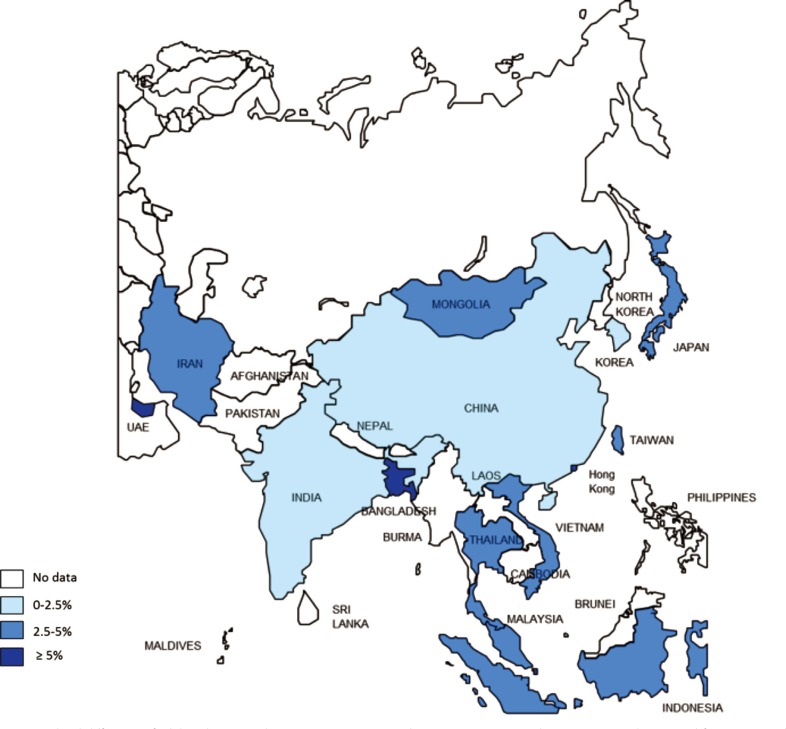




 PDF
PDF ePub
ePub Citation
Citation Print
Print



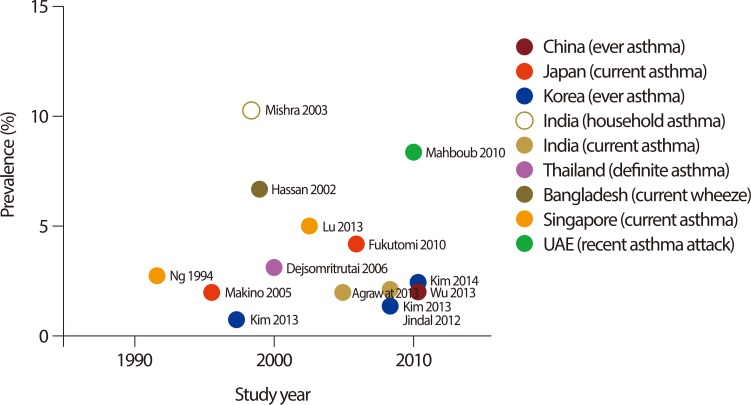

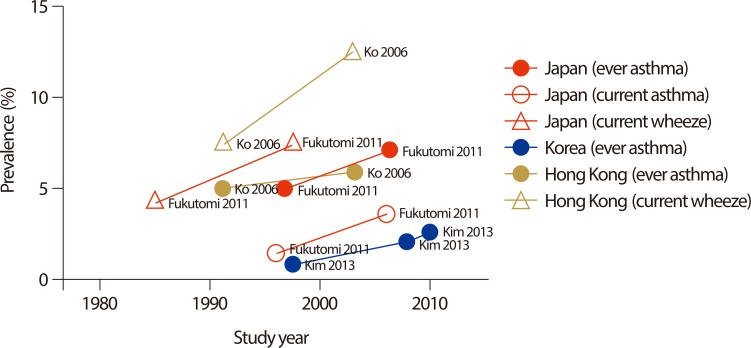
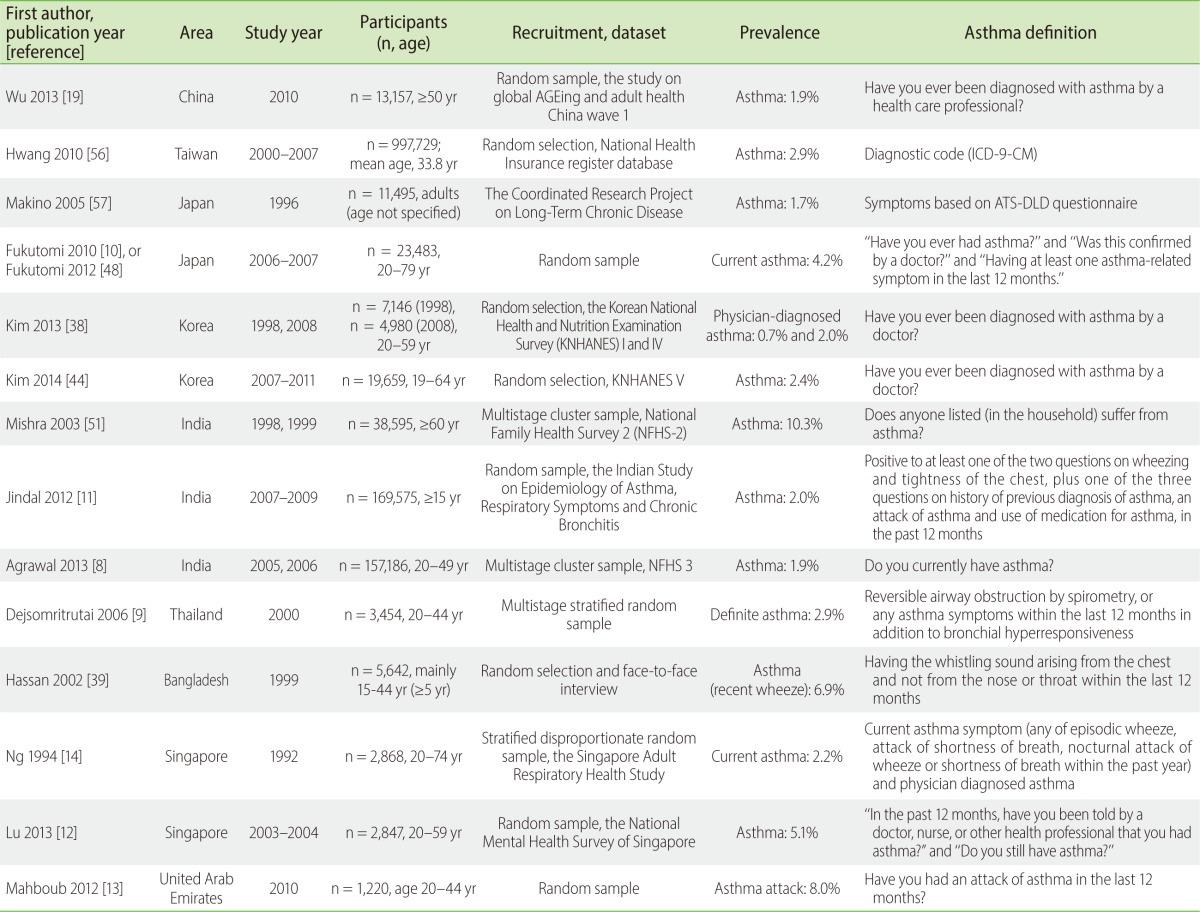
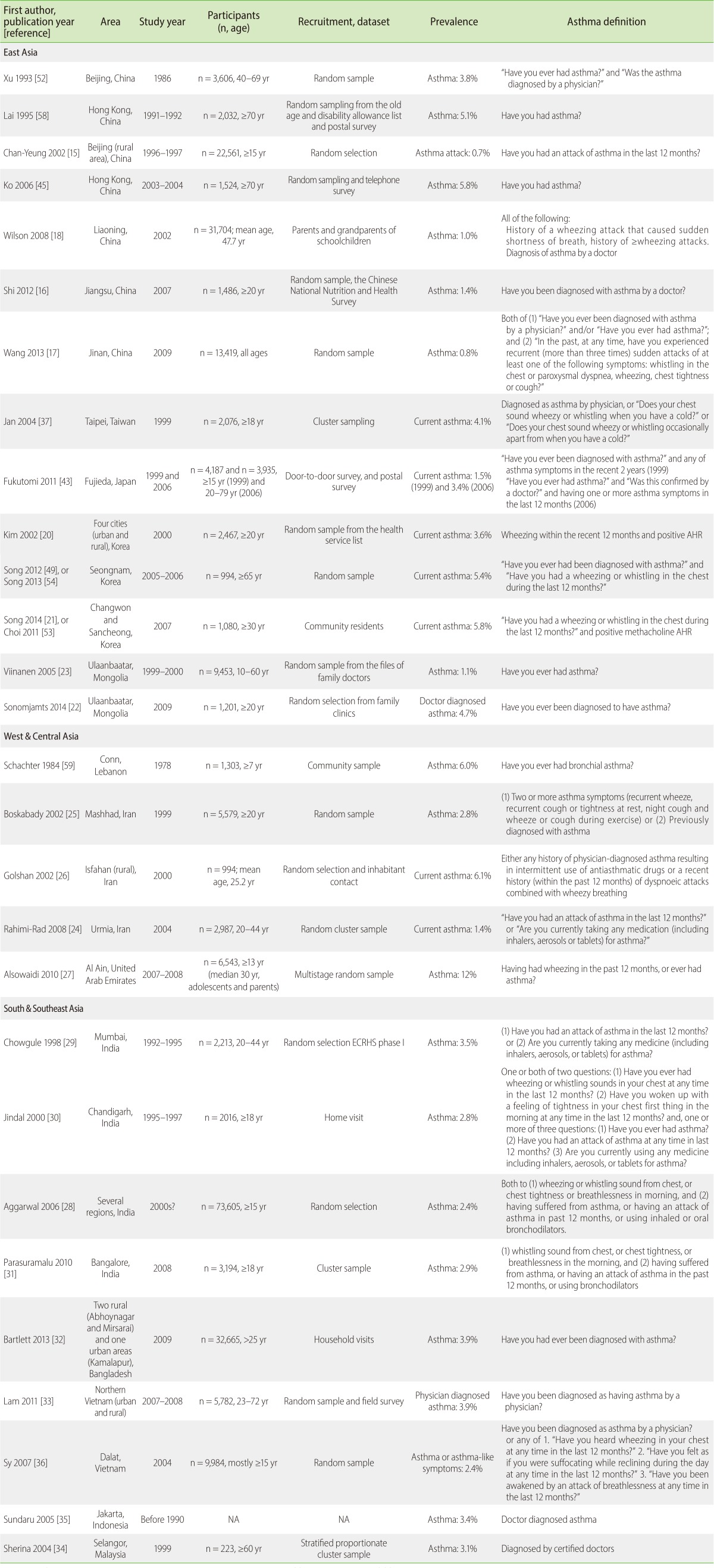
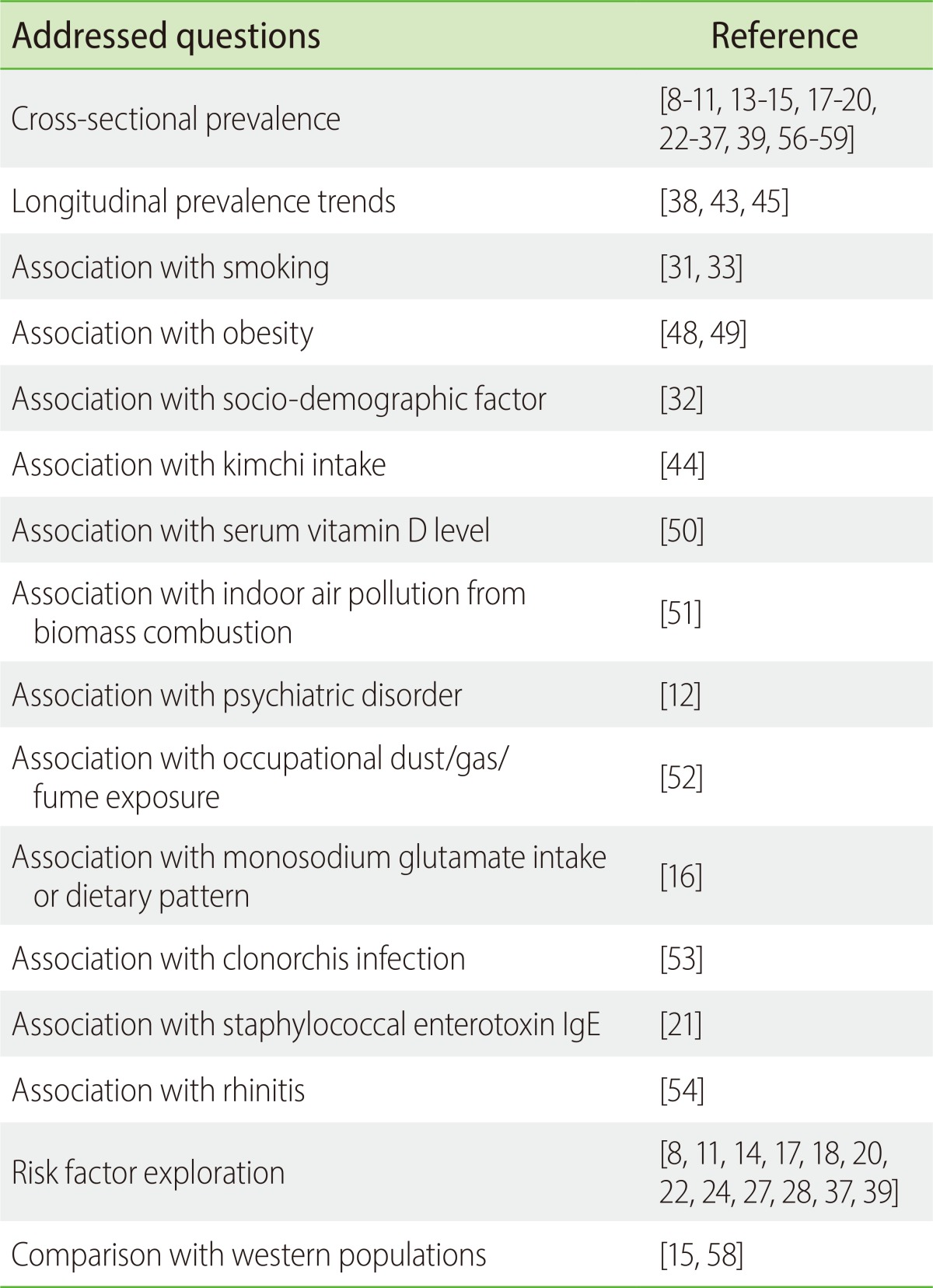
 XML Download
XML Download